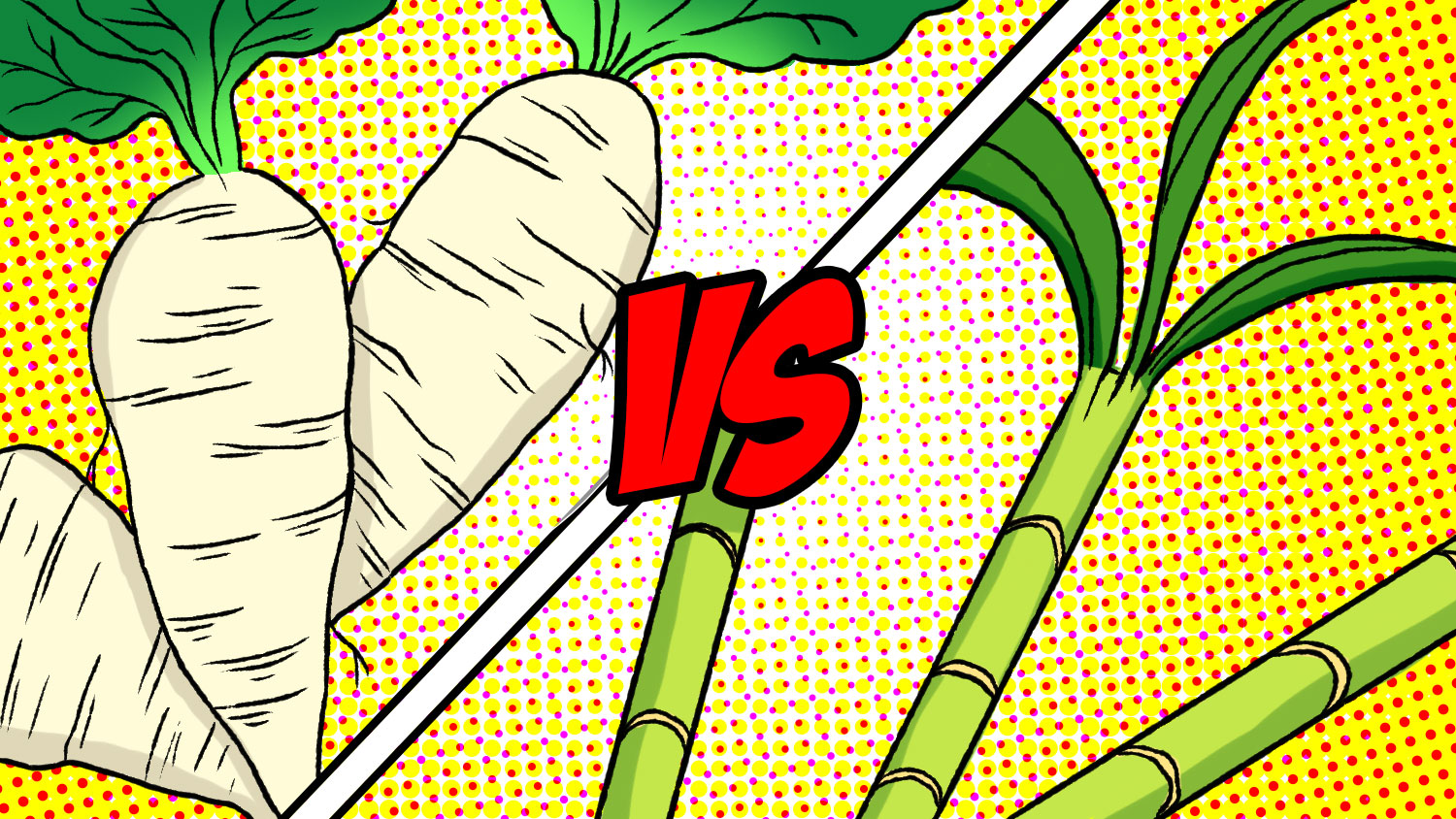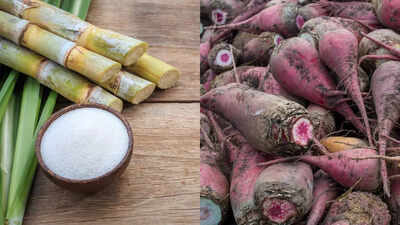Sugar beet vs sugar cane: Workforce needs in agriculture
Revealing the Fact Behind Sugar Beet Vs Sugar Cane: Benefits, Uses, and Processing Techniques Described
The difference in between sugar beet and sugar cane is frequently ignored in discussions about sugar manufacturing. Each plant provides distinct advantages and applications in different markets. Their cultivation techniques and handling strategies likewise vary notably. Comprehending these nuances is important for stakeholders in the sugar sector. What ramifications do these differences have for wellness, flavor, and ecological effect? Checking out these elements can reveal deeper insights into the global sugar market.

Introduction of Sugar Beet and Sugar Cane
Sugar beet and sugar cane are two main resources of sugar, each with unique qualities and cultivation approaches. Sugar beet, a root vegetable, thrives in pleasant environments and is normally gathered in the autumn. Its high sugar material, ranging from 15% to 20%, makes it a beneficial crop for sugar production. The process involves extracting juice from the beetroots, which is then fine-tuned right into granulated sugar.
On the other hand, sugar cane is a tropical yard that prospers in cozy, damp settings. It can accomplish a sugar content of up to 14%, but its high, coarse stalks require extensive processing. The cane is crushed to draw out juice, which goes through boiling and formation to generate sugar. Both resources contribute substantially to the worldwide sugar supply, with sugar beet primarily grown in Europe and North America, while sugar cane is chiefly expanded in Brazil, India, and various other exotic areas.
Growing Practices: Sugar Beet vs. Sugar Cane
Growing methods for sugar beet and sugar cane differ substantially as a result of their distinctive expanding problems. Sugar beets flourish in cooler environments with well-drained dirt, while sugar cane likes warmer temperatures and plentiful dampness. In addition, the harvesting strategies used for every crop mirror these ecological requirements and affect general yield and quality.
Expanding Problems Comparison
While both sugar beet and sugar cane grow in certain ecological conditions, their cultivation techniques vary considerably. Sugar beet is mostly expanded in warm areas, preferring cooler climates with well-drained soil and moderate rainfall. It calls for a growing period of regarding 90 to 120 days, with perfect temperatures in between 15 ° C to 25 ° C. On the other hand, sugar cane embellishments in exotic and subtropical climates, prospering in cozy temperature levels ranging from 20 ° C to 32 ° C. It needs plentiful sunlight and consistent rainfall, commonly requiring irrigation in drier locations. Sugar cane has a longer growing cycle, usually lasting 12 to 24 months. These differences in growing conditions greatly influence the geographical distribution and farming methods related to each plant.
Gathering Methods Differences
The harvesting strategies for sugar beet and sugar cane reflect their distinctive growth characteristics and agricultural methods. Sugar beet is usually collected mechanically, with farmers developed to uproot the entire plant, making sure marginal dirt disruption. The beets are after that moved for processing shortly after harvest to maintain top quality. On the other hand, sugar cane harvesting frequently includes a mix of manual and mechanical techniques. Employees might originally cut the cane by hand, specifically in areas where mechanization is less viable. Consequently, specialized equipment is used to gather and move the cut stalks to processing facilities. These varying methods not only impact performance yet additionally affect the quality and yield of the last sugar products, showcasing the adaptability of each crop to its setting.
Nutritional Comparison and Health Conveniences
When comparing the dietary profiles of sugar beet and sugar cane, it ends up being clear that each deals distinct health and wellness benefits. Sugar beets are rich in necessary nutrients like folate, manganese, and potassium, which contribute to total health. They likewise include fiber, which assists digestion and might assist regulate blood sugar degrees. Additionally, sugar beets are known for their antioxidant properties, which can deal with oxidative stress and anxiety.
Alternatively, sugar cane is primarily made up of sucrose, providing fast energy. While it does not have the exact same level of minerals and vitamins found in sugar beets, sugar cane does contain percentages of B nutrients such as calcium and magnesium. Additionally, sugar cane juice is often proclaimed for its hydrating homes and prospective health advantages, including boosted digestive system wellness. Eventually, the choice in between sugar beet and sugar cane might depend upon specific wellness objectives and dietary preferences.
Taste Accounts and Culinary Utilizes
Flavor accounts of sugar beet and sugar cane differ noticeably, influencing their culinary applications (Sugar beet vs sugar cane). Sugar cane, with its normally sweet and complex taste, is often favored in beverages, treats, and numerous culinary dishes. It lends a rich, caramel-like note that improves the preference of things such as syrups, molasses, and rum. On the other hand, sugar beet has an extra neutral and much less fragrant taste, making it appropriate for applications where sweetness is desired without altering the recipe's intrinsic tastes. It is regularly used in refined foods, baked items, and sugar
Culinary professionals typically choose sugar cane for its deepness and richness, particularly in premium food preparation and craft drinks. Alternatively, sugar beet's flexibility as a sweetener in mass-produced items satisfies a more comprehensive market. Eventually, the option between these two sugars can significantly impact taste accounts and general cooking experiences.
Ecological Influence of Sugar Manufacturing
Sugar production, whether from sugar beet or sugar cane, carries substantial environmental ramifications. Sugar cane cultivation usually brings about deforestation, particularly in exotic regions, interfering with regional ecosystems and adding to biodiversity loss. The considerable use fertilizers and chemicals in both sugar beet and sugar cane farming can result in soil destruction and water pollution, influencing surrounding environments and areas. In addition, the high water intake needed for sugar cane watering poses a threat to local water supplies, especially in deserts.
On the other hand, sugar beet farming generally happens in temperate climates, which may alleviate some logging concerns. It is not without its own difficulties, including soil erosion and dependence on chemical inputs. Overall, the environmental influence of sugar production is complex, demanding sustainable farming practices and understanding of source management to reduce damages to environments webpage and advertise environmental health.
Handling Strategies: From Plant to Sugar
Many handling strategies are used to change sugar beet and sugar cane into granulated sugar, each method Bonuses mirroring the unique characteristics of the source plant. For sugar beets, the procedure begins with cleaning and slicing the roots into slim strips, which are then subjected to diffusion-- a strategy where warm water extracts sugar from the beet pieces. The resulting liquid is detoxified, focused, and crystallized.
In contrast, sugar cane processing involves crushing the stalks to extract juice, followed by clarification to remove pollutants. The juice is after that vaporized, leading to syrup that goes through condensation. Both processes are complied with by separation of the sugar crystals from the molasses, which is a result. The lasts include drying out and packaging the granulated sugar for circulation. These strategies highlight the unique pathways where these two plants produce sugar, each with its very own collection of challenges and effectiveness.
Economic Aspects of Sugar Beet and Sugar Cane Industries
The economic landscape of the sugar beet and sugar cane markets reveals notable differences in production costs, market dynamics, and regional impacts. Sugar beet, largely expanded in temperate environments, commonly sustains higher manufacturing prices due to labor and input costs. Alternatively, sugar cane thrives in tropical areas, normally taking advantage of lower labor expenses and beneficial weather problems, which can result in higher yields.
Market dynamics additionally differ, as sugar cane controls international production, representing roughly 80% of sugar outcome. This occurrence affects rates structures and trade flows. On the other hand, sugar beet is a lot more regionally focused, especially in Europe and North America, affecting local economic climates based on beet production.
Changes in global sugar prices can considerably influence both sectors, affecting farmer revenue and financial investment levels. Understanding these financial aspects is important for stakeholders intending to navigate the complexities of the sugar market properly.

Frequently Asked Questions

Can Sugar Beet and Sugar Cane Be Intercropped Successfully?
Intercropping sugar beet and sugar cane provides challenges as a result of varying growth demands and ecological demands. Nonetheless, with mindful management and suitable conditions, it may produce benefits such as improved soil wellness and source effectiveness.
What Are the Historic Beginnings of Sugar Beet and Sugar Cane?
The historical beginnings of sugar beet trace back to 18th century Europe, while sugar cane has roots in Click This Link Southeast Asia, grown for hundreds of years. Both plants have actually substantially influenced international sugar production and agriculture.
Exactly How Do Sugar Beet and Sugar Cane Affect Soil Wellness?
The results of sugar beet and sugar cane on dirt health differ. Sugar beet can improve dirt framework and nutrient content, while sugar cane might deplete nutrients otherwise handled appropriately, influencing lasting soil fertility.
Are There Any Arising Technologies in Sugar Manufacturing?
Emerging technologies in sugar production consist of accuracy agriculture, advanced genetic modification for higher returns, and innovative extraction methods. These innovations intend to improve performance, reduce environmental influence, and boost the overall sustainability of sugar manufacturing processes.
What Are the Secret Distinctions in Labor Requirements for Both Plants?
The essential distinctions in labor demands for sugar beet and sugar cane lie in planting, harvesting, and handling. Sugar beet vs sugar cane. Sugar beet usually requires even more automation, while sugar cane commonly needs much more manual work for harvesting and processing phases